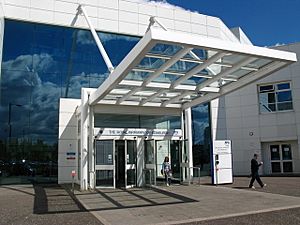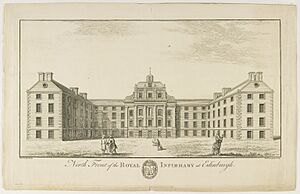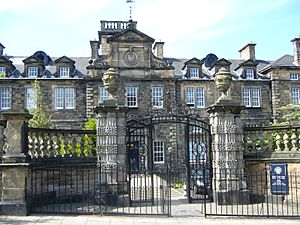Royal Infirmary of Edinburgh facts for kids
Quick facts for kids Royal Infirmary of Edinburgh |
|
|---|---|
| NHS Lothian | |

Main entrance
|
|
| Geography | |
| Location | Little France, Edinburgh, Scotland |
| Coordinates | 55°55′22″N 3°08′12″W / 55.9229°N 3.1366°W |
| Organisation | |
| Care system | NHS Scotland |
| Hospital type | Teaching |
| Affiliated university | University of Edinburgh Medical School |
| Services | |
| Emergency department | Yes |
| Beds | >900 |
| History | |
| Founded | 1729 |
The Royal Infirmary of Edinburgh (often called the RIE) is a very old hospital in Scotland. It started way back in 1729, making it the oldest hospital in Scotland that relied on donations. In 1879, new buildings were built, and they were thought to be the largest hospital of their kind in the United Kingdom.
The hospital moved to a new site in 2003 in Little France. This new hospital has over 900 beds. The RIE is a teaching hospital for the University of Edinburgh Medical School. This means doctors and nurses learn there.
Some amazing medical firsts happened here:
- In 1960, the first successful kidney transplant in the UK took place at the RIE.
- In 1964, the world's first special unit for heart attacks (called a coronary care unit) was set up here.
Today, it's the only place in Scotland for certain organ transplants, like liver and pancreas transplants. It's also one of two places for kidney transplants. In 2012, the hospital's emergency room helped 113,000 patients, which was the most in Scotland. The hospital is managed by NHS Lothian.
Contents
Hospital History
How the Hospital Started
The idea for the Royal Infirmary began with John Munro, a surgeon in Edinburgh. In 1721, his son, Alexander Monro, who was a professor, wrote about how important it was to have a hospital for sick and poor people.
Many people helped make the hospital happen. The Royal College of Physicians of Edinburgh suggested that a fishing company, which was closing down, should give its money to start the hospital. Rich citizens, doctors, and churches also donated money.
The First Hospital Building
In 1729, a small house was rented near the university. It was first called the Hospital for the Sick Poor or the Little House. It opened on August 6, 1729, on a street that is now called Infirmary Street. A plaque marks the spot today.
The hospital hired a "Mistress" (like a housekeeper) and a "Nurse" to care for patients. Doctors and surgeons also volunteered their time and even provided medicines for free. The first patient, a lady from Caithness, got better after three months. In the first year, 35 patients were admitted. Most of them got better or were cured.
Many people also came for free advice and medicine as out-patients. This service became very popular, but it was also very expensive for the hospital. So, they started raising money for a bigger hospital.
Infirmary Street Building
In 1736, King George II gave the hospital a special Royal Charter. This officially named it the Royal Infirmary of Edinburgh. A famous architect named William Adam designed a new, much larger hospital building nearby.
The hospital moved into the new building in 1741, even before it was finished. When it was completed in 1745, it had 228 beds. The old "Little House" only had 4 beds.
A Difficult Part of History
In 1750, a Scottish surgeon named Archibald Kerr left a large farm in Jamaica called Red Hill Pen to the Royal Infirmary. This farm used forced labor. The hospital owned this farm from 1750 to 1893. The money made from this farm was used to buy medicines, build new parts of the hospital, and pay staff.
In 2023, the health board that runs the Royal Infirmary said they would make up for this past connection to forced labor.
Growing Pains and New Buildings
By the 1830s, the hospital needed more space. In 1832, a nearby old school building was turned into a surgical hospital. But this was still not enough. So, a new surgical hospital was built on Drummond Street, opening in 1853.
The original Infirmary Street buildings were taken down in 1884. Today, public swimming pools and a school are there. Some parts of the old hospital, like its ornamental gates and a surgical theatre, were moved to other locations in the city.
The "New System" for Nurses
Big changes happened in 1873 with something called the "New System." Four years before, Sir Joseph Lister, a famous surgeon, had joined the hospital. He used antiseptics to prevent infections, which made his surgeries very successful. This attracted more patients to the hospital.
The hospital managers felt their nurses needed more training. So, they hired Charles Hamilton Fasson as the Medical Superintendent. He brought 17 trained nurses from St. Thomas’s Hospital in London, who had been taught by Florence Nightingale.
In 1873, Elizabeth Barclay and Angélique Lucille Pringle started a new way of nursing. Nurses were now managed by a Lady Superintendent, not by individual doctors. They also started a proper training program for nurses. After one year of training, nurses were added to the Royal Infirmary's official register. This was the first nursing school in Scotland!
Lauriston Place Hospital
In 1879, the Royal Infirmary moved to a new, larger site on Lauriston Place. This area was on the edge of the city, where the air was fresher. The new hospital was designed by David Bryce. It included parts of an old school building that used to be there.
In the 1920s, the hospital needed to grow again. Another school moved so that the hospital could expand. In 1932, a new maternity wing, called the Simpson Memorial Pavilion, was built. In 1948, the hospital became part of the National Health Service (NHS).
In 2001, the Lauriston Place site was sold. It has since been turned into a new area with homes, shops, and hotels called the Quartermile. Many of the old hospital buildings were kept and can still be seen.
Moving to Little France
A brand new hospital was built at Little France, in the southeast of Edinburgh. This new location was chosen to serve people from Edinburgh and nearby areas like Midlothian and East Lothian. The new hospital is connected to the University of Edinburgh Medical School's main teaching building.
The new building cost £184 million and opened in 2003. It was designed by Keppie Design and built by Balfour Beatty.
When it first opened, some people in the local news were concerned. They worried that the main emergency room was too far from the city center. They also thought public transport to the new site was not good enough.
In 2012, the hospital started new heart procedures called TAVI, which were the first of their kind in Scotland. In 2014, Scotland's first PET-MRI Scanner was placed at the Royal Infirmary.
In 2016, the Royal Infirmary became one of four main trauma centers in Scotland. These centers provide special care for very serious injuries. In 2021, a new hospital for children and young people opened right next to the Infirmary at Little France.
Key Achievements
The Royal Infirmary of Edinburgh has been a leader in many medical fields:
- 1960 - First kidney transplant in the UK by Sir Michael Woodruff.
- 1964 - World's first Coronary Care Unit started by Desmond Julian.
- 2000 - Scotland's first combined kidney and pancreas transplant.
- 2008 - Scotland's first live donor liver transplant by Murat Akyol and Ernest Hidalgo.
- 2011 - Scotland's first pancreatic islet cell transplantation.
- 2012 - Scotland's first TAVI (transcatheter aortic valve replacement) performed by Neal Uren.
The Infirmary in Stories
The Royal Infirmary of Edinburgh has appeared in many books and stories. People have written about what it was like to be a patient or to work there. For example, the English poet William Ernest Henley stayed at the RIE for three years (1873–75). He wrote poems about hospital life and the nurses he met.
Nursing History at the Royal Infirmary
From 1729, when the hospital was in "The Little House," the head nurse was called a "Mistress." Her job was more like a housekeeper, but she also gave out medicines. Medical students often helped care for very sick patients.
The title "Mistress" changed to "Superintendent of Nurses" in 1866, and then to "Lady Superintendent of Nurses" in 1872.
Lady Superintendents of Nurses
Here are some of the important Lady Superintendents:
- Miss Elizabeth Anne Barclay (1872 – 1887): She helped start the Royal Infirmary of Edinburgh’s School of Nursing in 1872. She was a Nightingale nurse and had worked in hospitals in Germany.
- Miss Angelique Lucille Pringle (1874 – 1887): She later became the Matron of St Thomas’s and Superintendent of the Nightingale School.
- Miss Frances Elizabeth Spencer (1887 – 1907): She set up awards for nurses and arranged for them to have tutorials.
- Miss Annie Warren Gill CBE, RRC & Bar (1907 – 1925)
- Miss Ellen Frances Bladdon (1925 – 1931)
- Miss Elizabeth Dunlop Smaill (1931 – 1944): She had worked as a nurse in wars in Bulgaria and France.
- Miss Margaret Colville Marshall (1944 – 1955): She was the Chief Nursing Officer in the Scottish Department of Health when the NHS began.
- Miss Ida Barbara Helen Quaile (nee Renton), OBE (1955 – 1959)
- Miss Mary Hutcheson Cordiner (1959 – 1967)
- Miss Muriel Florence Cullen (1967 – 1972): She later became the Chief Nursing Officer.
Other Important Nurses
- Alice Fisher (1839 – 1888): She was a leader in nurse education and wrote a book called Hints for Hospital Nurses.
Famous Patients
- Former UK Prime Minister Gordon Brown had eye surgery here when he was a student at the University of Edinburgh. He had a serious eye injury after a rugby union accident.
- The former leader of the Scottish Conservatives, Ruth Davidson, gave birth to her son Finn at the hospital in 2018.
See also
- Western General Hospital
- Royal Hospital for Sick Children, Edinburgh
- Longmore Hospital





